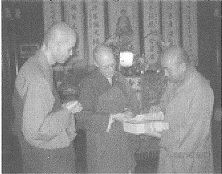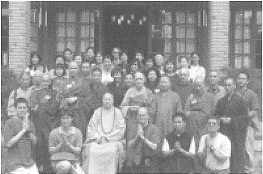|
真如禪寺的主持是一位很年青的比丘 ─純聞法師,他是中國最年輕的方丈。他親自帶領幾位法師到機場大樓迎接法總訪問團,又和寺廟僧眾以隆重的佛教儀式迎接訪問團入寺。
純聞方丈帶領著我們進入大雄寶殿上香禮佛,一片既莊嚴又祥和的氣氛隨著香煙繚繞, 洗滌了內心的塵垢。這一刻真有「不可說, 不可說」的妙樂!
真如禪寺是中國名聞遐爾,精修禪宗的寺廟。虛雲老和尚是近代的禪宗泰斗,1959年以120之高齡在此寺圓寂。虛老的清苦修持,令人感動。僧眾仍秉持著虛老「農禪並重」的一貫作風,自耕自給!所出產的茶葉遠近馳名。
寧波阿育王寺是供奉佛身舍利的國有寺廟,也是一座不做法事,不趕經懺,沒有攤販的寺廟。該寺雖位於大城市中,但它的清幽恬靜,實屬少見。阿育王寺的住持界源長老得知訪問團到訪,親自接待並講解阿育王寺佛身舍利的緣由。訪問團真是幸運,再次得以瞻仰禮拜佛的舍利!
 |
界源方丈講解阿育王寺誌
The Abbot Jie Yuan explained the history of the King Asoka Monastery |
天臺山是訪問團行程中最後的一站。國清講寺是天臺宗的祖庭,更是韓國、日本佛教人士每年來朝拜的天臺宗寺廟。智者大師是開山祖師,他的真身也在此地。這裏也是寒山、拾得和豐干三位祖師常住之處。據說,有緣人至今還可見到這些祖師示現,教化眾生。
國清講寺的方丈可明老和尚已年過九旬,精神抖擻。老和尚非常慈悲為我們開示並詳述該寺的歷史文化。現存的隋代寶塔仍然屹立不倒,該寺的草根菩提子亦是難得一見的植物。
有關國清寺的來歷有一個傳說:很久以前,智者大師來到天臺山,他想找一個地方來建道場。在沒有找到之前,他坐在山上的大石上看經,可是風太大了,把他的一片經書吹跑了。這片經書不停的飛啊,飛啊,飛到山谷中的平原才停下來。智者大師一路追,追到之後才發現這塊平原是多麼的靈秀!因此就在這塊寶地蓋廟了。國清寺從隋代到現在,還保留了很多古物,如超過1,400年的楊梅樹,(我們還趕上了收成的時侯,所以也能嚐到它的美味),隋塔、菩提樹、千年的唐樟等等,都是難得一見的!
天臺山佛學院是設在萬年禪寺內。該寺位在高高的山上,迂回曲折的山徑,望眼都是蒼松翠柏,空氣清新,是潛心修煉的好地方。難怪該寺的住持允觀法師,把佛學院選擇在此!
一個五百羅漢鬥觀音的有趣故事就是發生在這個幽雅的地方。據說很久以前, 五百羅漢來到天臺山,聽聞眾人都說觀音菩薩的神通廣大,心裏覺得不服。因此就要和觀音鬥法,看誰的神通了得。五百羅漢於是想出一個妙計,信心十足地認為他們一定會贏過觀音的。他們興高采烈的就去找觀音菩薩:「我們來蓋一個塔,你來蓋一條橋樑,看誰能在雞鳴天亮時先蓋好,誰就贏,誰的神通就大,你願意嗎?」觀音菩薩答應了。五百羅漢心裏竊笑,認為他們必贏無疑的。
羅漢們同心合力利用神通,將磚塊運來建塔,大家都忙得不可開交,看看時間也快天亮了,雖然塔還沒有完成,可是觀音菩薩卻還沒有開始建她的橋梁,五百羅漢正在竊喜的時候,卻聽到了雞鳴數啼。這個時刻,五百羅漢所蓋的塔還沒有封頂,也只得停下來;他們跑去看觀音的橋梁,卻見它已經橫跨瀑布之上了。他們只有服輸,甘拜下風。大家知道為甚麼觀音菩薩這麼快就建好了橋梁嗎?原來觀音菩薩在那兒一觀察,就看到有兩條水龍正在那裡嬉戲,於是她就請牠們幫忙合成一條石的橋梁,然後觀音菩薩學雞鳴,因此五百羅漢便輸了!據說現在天臺山一帶的塔,都沒有塔頂就是這個原因。
這個傳說故事,讓我們知道一個道理,就是不要以勢壓人,以眾欺寡;更不應當以為自己有點神通、有點修行,就目空一切,目中無人。需知「天上有天」,謹供大家以此借鑒!
上海是訪問團離開中國返回美國的一個口岸。在這十里洋場的大都市裡有不少的素菜館,裝飾得清麗雅致,素菜款式講究衛生和營養,座上客多是年青人。訪問團大快朵頤後,欣然重返家園,十四天的旅程就此圓滿!
這次訪問團所到之處都是備受歡迎,實在是因為我們的師父,宣公上人的德行感召,深入眾人心中!我們每到一個地方,無論是大城市或是小鄉鎮,繁華都市或窮鄉僻壤,聽到宣公上人的法號,莫不讚頌不已!在中國,虛雲老和尚無人不曉,無人不知外,宣公上人的名字可以說是僅跟其次。
令人驚奇的,不管是幾十年半閉關的彌光老和尚的關房內,還是名聞遐邇的大靈光寺的小商場內,都可以看到上人的經典淺釋,人人都要珍藏保存,或是一睹為快!甚至於有些人冒著犯法,出資翻印流通都在所不惜,他們都渴望得到上人的教化,佛法的薰習。我們身為上人的弟子,迴光返照,是否應珍惜我們所擁有的呢?我們是不是應當循著上人的教導,弘法利生,以報師恩呢?但願世界眾生,能沐上人法雨,得大菩提!
全文完
|
|
The Abbot here is a young Bhikshu named Dharma Master Cun Wen. He is the youngest abbot in China. Accompanied by some other Dharma Masters, he welcomed the Dharma Realm Buddhist Association (DRBA) delegation upon its arrival at the airport. He then welcomed the delegation into the monastery with a grand Buddhist ritual.
Abbot Chun Wen led us into the grand hall to offer incense and bow to the Buddhas. The atmosphere was solemn and auspicious as the incense smoke spiraled in the air and seemed to cleanse our inner impurities. It was an ineffable and wonderful moment of bliss!
Zhenru Monastery is renowned in China for specializing in Chan meditation. Elder Master Xu Yun was one of the greatest contemporary Chan Masters. He entered Nirvana here in 1959 at the venerable age of 120 years. His distinct and rigorous way of meditative practice was quite inspiring. The Sangha here maintained Elder Master Yun’s style of placing equal emphasis on farming and meditation. The farming enables the monastery to be self-sufficient. The tea they produce is known far and wide.
King Asoka Monastery at Ningbo is a national temple where people worship the enshrined relic of the Buddha. It’s also a temple without any Dharma ceremonies, repentance ceremonies for the deceased, or peddlers. Despite its location in a big city, a rare and unique peace and quiet pervaded the monastery. When he heard of our arrival, the Abbot of King Asoka Monastery, Elder Master Jie Yuan, personally received the delegation and then explained the origin of the temple’s Buddha relic. It was a great blessing for the delegation to pay reverence to the relic of the Buddha.
Tiantai Mountain was the last stop on the delegation’s itinerary. Guoqing (National Purity) Monastery is one of the major temples of the Tiantai School. It’s also visited by Buddhist disciples from Korea and Japan every year.
 |
可明方丈與訪問團合照
Group picture of Abbot Ke Ming and the delegation |
Great Master Zhi Zhe founded the school at this place, and his body was placed here as well. It’s also the place where the three great Patriarchs, Masters Han Shan, Shi De and Feng Gan, reside. Some people with affinities indicated that they constantly see these three patriarchs manifesting here to teach and transform beings.
The Abbot of Guo Qing Monastery, Elder Master Ke Ming, is over ninety years old, yet he is still full of energy. The Elder Master compassionately gave us a Dharma talk and related the history and culture of the monastery. A pagoda built in the Sui Dynasty still stood upright, and a shoot that had sprouted from the Bodhi seed was also a rare plant.
The following is a splendid legend about the history of Guoqing Monastery: A long time ago when the Venerable Master Zhi Zhe arrived at Tiantai Mountain, he was looking for a place to start a monastery. While he was reading a sutra on a big rock on the mountain, the wind blew away some pages of the Sutra. These pages kept hovering and fluttering in the air until they landed on the plateau in the valley. Great Master Zhi Zhe kept running after the pages as they were blown away. When he finally retrieved the Sutra pages, he discovered the beautiful plateau where the pages had landed. Then he built a temple on this precious land. From the time of the Sui Dynasty until now, Guoqing Monastery has kept numerous rare historical relics including a 1,400-year old red bayberry tree (we happened to arrive at harvest time and got to taste its delicious fruit), the Sui Dynasty Pagoda, a Bodhi tree, and a 1,000-year-old Tang dynasty camphor tree.
Tiantai Buddhist Academy was established in Wannian (Ten Thousand Years) Monastery, located high in a mountainous area. The trail twists and turns through scenic green pines and cypresses. With its beauty and invigorating atmosphere, it’s a great place for practicing meditation. No wonder the Abbot, Dharma Master Yunguan, had the wisdom to build the Buddhist Academy here!
This serene place was also the setting for the famous story of the contest between the five hundred Arhats and Guanyin Bodhisattva. Long ago, five hundred Arhats visited Tiantai Mountain and were not convinced of the great spiritual power of Guanyin Bodhisattva. In order to see who had the greater spiritual powers, they challenged the Bodhisattva. They thought that they could defeat Guanyin Bodhisattva. They told Guanyin Bodhisattva, “We will build a pagoda, and you can build a bridge. Whoever finishes before the rooster crows at dawn wins. This will show who has greater spiritual power. Will you do it?” Guanyin Bodhisattva agreed. The Five Hundred Arhats assumed that they would win.
The Arhats worked together and utilized their spiritual power to transport bricks for the pagoda. They worked busily without taking a break. When it was almost daybreak, they had not yet finished the pagoda. However, Guanyin Bodhisattva hadn’t even started building the bridge yet. While the five hundred Arhats were laughing, they heard a rooster crow. They had to stop working on the pagoda, even though they hadn’t yet finished the top of the pagoda. Guanyin Bodhisattva, however, had already built a bridge across the waterfall. The Arhats had no choice but to admit defeat and acknowledge the Bodhisattva’s superior powers. How did Guanyin Bodhisattva build a bridge so quickly? It was because Guanyin Bodhisattva observed two dragons playing nearby and asked them to help build the stone bridge. And then Guanyin mimicked the crowing of the rooster. Thus, the five hundred Arhats lost the competition. People said that this was the reason that the pagodas in the Tiantai Mountain area have no tops.
There is an important lesson to be learned from this story. That is, that one should not oppress or take advantage of others. We shouldn’t be arrogant and pompous about having some spiritual power or some accomplishment in our cultivation. There is always another heaven above the one that we know. We should all take note of this!
Shanghai was the port where the delegation left China to return to America. There were lots of vegetarian restaurants in this metropolis. These restaurants were gracefully decorated, and their cuisine was tasty and nutritious. This obviously appealed to the many young people who filled the restaurant. After the delegation had the opportunity to partake of the savory food, everybody was happily ready to return home.
The delegation had been cordially welcomed everywhere they went in China. This was due to the fact that our hosts had all been insipred by the Venerable Master Hua’s virtuous deeds. Whether we traveled to a big city, a little town, a bustling city, or a remote country village, all the people lauded the Venerable Master Hua. The Venerable Master Hua was as well-known and as well-regarded as the Great Master Xu Yun.
Most surprisingly, we encountered the Sutra commentaries of the Venerable Master Hua everywhere, from the hut of the Elder Monk Mi Guang who had dwelt in seclusion for several decades to the small bazaar in the famous Dalingguang (Great Efficacious Light) Monastery. Everyone wanted to collect, preserve or read them. Some even risked violating the law to reprint and circulate them with their own expense. As the disciples of the Venerable Master, we should reflect on and cherish what we have. We should follow his teaching and propagate the Dharma to benefit living beings, in order to repay his kindness. May all beings in the world benefit from his Dharma rain and realize great enlightenment!
The End |